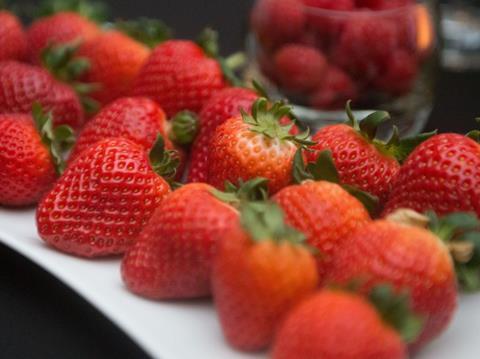
Brexit aside, it’s business as usual for the berry category, and at this time of year that means the peak of the season and the crucial Wimbledon supply period.
Due to a late season, sales are running slightly behind last year, according to chairman of trade body British Summer Fruits (BSF), Laurence Olins, with strawberries down by around 12 per cent on tonnage.
Raspberries are up five per cent and blackberries are up 10 per cent, with strawberries expected to catch up by the end of the season and demand described as “excellent”. “Forecasts were quite optimistic, showing 10 per cent up on last year. We will hopefully match last year, although it may flatline,” says Olins.
Sales and procurement director at soft-fruit marketer Berry Gardens, Jacqui Green, says: “As always Wimbledon is a key driver for strawberries, but with the unpredictable weather we have experienced over the last few months, volumes have been a challenge on occasion. However, fruit has been on the plants for longer and has been able to develop good Brix levels resulting in fantastic eating quality.”
Elsewhere in the category, procurement manager at berry supplier Wellpak, Laura Rose, says blueberry supply over the past couple of months has been “very difficult”. “Spanish volumes were much lower than anticipated due to adverse weather. This continued with the Italian season, where hail and thunderstorms damaged many crops,” she says. “Wellpak covered this difficult period with USA airfreight production to ensure full availability. We are now starting with Polish and Portuguese fruit, and volume looks stable.”
British blueberries continue to gather momentum, meanwhile, and Green says Berry Gardens’ growers are increasing plantings across the UK. “All categories are seeing growth – in particular raspberries with an increase in value of 23.2 per cent and blueberries with a 26.7 per cent increase. We would attribute this partly to the introduction of larger packs in several retailers.”
Olins adds: “Mixed packs are good for introducing new crops. But the low weight means they’re not useful for shifting big volumes. I would much rather see bigger packs of the main lines. Moving from 150 to 300g in blues makes more sense to me.
“The category is still seeing 17.7 per cent year-on-year growth, compared to 5.3 per cent on total fruit. Within that, strawberries are seeing 12 per cent, raspberries and blueberries are at 25 per cent, and blackberries are at 11 per cent.
“Within the category, growth will be driven by the three minor crops. We might see strawberries drop from 12 down to six, simply because of the growth in the others. Strawberries might be a possible victim.”
Convenience and snacking continue to be a big driver of berry growth, continues Green, and says this year Berry Gardens trialled a secondary chilled site in some Tesco stores, positioned near the food-to-go area. “We are currently looking at additional trials and further sites,” she says.
Berry-eating occasions have been a key area of focus for the industry’s promotional campaign, Seasonal Berries, but Olins says the trade body has scrapped its proposed ‘lunchtime walkabout’ campaign, in favour of a more targeted link between berries and brainpower, fronted by Countdown’s Rachel Riley.
Online sales of berries are growing at just under five per cent, Green adds, noting that the company is seeing berries increasingly bought as a snack in small ready-to-eat formats, as well as larger 1kg packs.
One of the biggest fears post-Brexit has been the short-term impact on exchange rates – something that is already being felt in the berry category, according to Pascal Simian, director of non-profit berry marketer Berry Alliance. “Brexit has already had an impact. The British pound’s exchange rate against the euro and the US dollar is already making imports more expensive. If this trend continues in the months to come then next winter this price hike will certainly translate into higher retail prices, which could have an impact on the growth of the category.”
Much was made of the berry’s category reaching the impressive £1 billion mark last year, but Simian believes that to continue this growth, the industry must guard against commoditisation. “Discounters are becoming an important player in the berry category,” he says.
“This puts pressure on the supply chain to ensure that the category is not commoditised and continues to deliver to consumers’ expectations. Consumers tend to have a stronger emotional connection to berries than any other fruit – they symbolise summer, health, pleasure. The supply chain faces the challenge of continuing to satisfy this connection while managing cost savings at the same time.”



